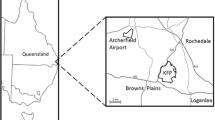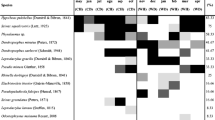Abstract
Anuran populations are sensitive to changing environmental conditions and act as useful indicators. Presently, much information collected concerning frog populations comes from volunteers following the North American Amphibian Monitoring Protocol. Does weather variability allowed within protocol affect the abundance of calling frogs? For 10 years, Credit Valley Conservation (Ontario, Canada) has been collecting anuran data concerning nine frog species employing three frog monitoring runs. Records include frog abundance by protocol code and five weather variables. Antecedent precipitation and temperature were determined from the nearest weather station. Locations with large source populations of two Hylidae species were selected (spring peeper calling in April and gray tree frog in May). Spearman correlations suggested there were no significant relationships between calling abundance of Hylidae species and ambient wind speed or humidity. However, gray tree frogs were temperature sensitive and calling was significantly related to increased water and air temperatures as well as day time high temperatures over the previous 2 weeks. Both species of calling Hylidae were affected by the volume and timing of precipitation (though, in different ways). Gray tree frogs seem to prefer drier conditions (when temperatures are significantly warmer) while spring peepers prefer to call during, or closely following, precipitation. Monitors targeting gray tree frog should track local weather conditions and focus on evenings when it is (a) warmer than the minimum temperatures and (b) drier than suggested by the protocol. It is recommended that an additional monitoring run could be added to reduce detection variability of this species.

Similar content being viewed by others
References
Beebee, T. J. C., & Griffiths, R. A. (2005). The amphibian decline crisis: a watershed for conservation biology? Biological Conservation, 125, 271–285.
Beever, E. A., & Woodward, A. (2011). Design of ecoregional monitoring in conservation areas of high-latitude ecosystems under contemporary climate change. Biological Conservation, 144, 1258–1269.
Bishop, C. A., Green, D. M., & Brooks, R. J. (1997). Validation tests of an amphibian call count survey technique in Ontario, Canada. Herpetologica, 53(3), 312–320.
Cadman, M. D., Sutherland, D. A., Beck, G. G., Lepage, D. & Couturier, A. R. (2007). Atlas of the breeding birds of Ontario: 2001–2005. Bird Studies Canada, Port Rowan.
Carey, C., & Alexander, M. A. (2003). Climate change and amphibian declines: is there a link? Diversity and Distributions, 9(2), 111–121.
Conrad, C. C., & Hilchey, K. G. (2011). A review of citizen science and community based environmental monitoring: issues and opportunities. Environmental Monitoring and Assessment, 176(1–4), 273–291.
Credit Valley Conservation (CVC). (2009). Integrated watershed monitoring program: anuran monitoring report. Mississauga: Credit Valley Conservation.
Crouch, W. B., & Patten, P. W. C. (2002). Assessing the use of call surveys to monitor breeding anurans in Rhode Island. Journal of Herpetology, 36(2), 185–192.
Cushman, S. A. (2006). Effects of habitat loss and fragmentation on amphibians: a review and prospectus. Biological Conservation, 128, 231–240.
Dickinson, J. L., & Bonney, R. (2012). Citizen science: public participation in environmental research. Ithaca: Comstock.
Ellingson, A. R., & Lukacs, P. M. (2003). Improving methods for regional landbird monitoring: a reply to Hutto and Young. Wildlife Society Bulletin, 31(3), 896–902.
Formicki, G., Zamachowski, W., & Stawarz, R. (2003). Effects of UV-A and UV-B on oxygen consumption in common toad (Bufo bufo) tadpoles. Journal of Zoology, 259(3), 317–326.
Gayou, D. (1984). Effects of temperature on the mating call of Hyla versicolor. Copeia, 1984(3), 733–738.
Gerhardt, H. C. (1978). Temperature coupling in the vocal communication system of the gray tree frog Hyla versicolor. Science, 199, 992–994.
Gibbs, J. P., & Breisch, A. R. (2001). Climate warming and calling phenology of frogs near Ithaca, New York. 1900–1999. Conservation Biology, 15(4), 1175–1178.
Gooch, M. M., Heupel, A. M., Price, S. J., & Dorcas, M. E. (2006). The effects of survey protocol on detection probabilities and site occupancy estimates of summer breeding anurans. Applied Herpetology, 3(2), 129–142.
Guzy, J. C., McCoy, E. D., Devle, A. C., Gonzalez, S. M., Halstead, N., & Mushinsky, H. R. (2012). Urbanization interferes with the use of amphibians as indicators of ecological integrity of wetlands. Journal of Applied Ecology, 49(4), 941–952.
Hauselberger, K. F., & Alford, R. A. (2005). Effects of season and weather on calling in the Australian microhylid frogs Austrochaperina robusta and Cophixalus ornatus. Herpetologica, 61(4), 349–363.
Hegg, D., Giroir, T., Ellenberg, U., & Seddon, P. J. (2012). Yellow-eyed Penguin (Megadyptes antipodes) as a case study to assess the reliability of nest counts. Journal of Ornithology, 153(2), 457–466.
Hersikorn, B. D., & Smits, J. E. G. (2011). Compromised metamorphosis and thyroid hormone changes in wood frogs (Lithobates sylvaticus) raised on reclaimed wetlands on the Athabasca oil sands. Environmental Pollution, 159(2), 596–601.
Hossack, B. R., Diamond, S. A., & Corn, P. S. (2006). Distribution of boreal toad populations in relation to estimated UV-B dose in Glacier National Park, Montana, USA. Canadian Journal of Zoology, 84(1), 98–107.
Jordan, R., Brooks, W., Howe, D., & Ehrenfeld, J. (2012). Evaluating the performance of volunteers in mapping invasive plants in public conservation lands. Environmental Management, 49(2), 425–434.
Kats, L. B., & Ferrer, R. P. (2003). Alien predators and amphibian declines: review of two decades of science and the transition to conservation. Diversity and Distributions, 9(2), 99–110.
Konze, K., & McLaren, M. (1997). Wildlife monitoring programs and inventory techniques for Ontario. Ontario Ministry of Natural Resources, Northeast Science and Technology. Technical Manual TM-009.
Krishnamurthy, S., & Smith, G. (2011). Combined effects of malathion and nitrate on early growth, abnormalities, and mortality of wood frog (Rana sylvatica) tadpoles. Ecotoxicology, 20(6), 1361–1367.
LaCommare, K. S., Brault, S., Self-Sullivan, C., & Hines, E. M. (2012). Trend detection in a boat-based method for monitoring sirenians: Antillean manatee case study. Biological Conservation, 152, 169–177.
Longcore, J. R., Longcore, J. E., Pessier, A. P., & Halteman, W. A. (2007). Chytridiomycosis widespread in anurans of Northeastern United States. The Journal of Wildlife Management, 71(2), 435.
Mann, R. M., Hyne, R. V., Choung, C. B., & Wilson, S. P. (2009). Amphibians and agricultural chemicals: review of the risks in a complex environment. Environmental Pollution, 157(11), 2903–2927.
Milne, R., Rosolen, S., Whitelaw, G., & Bennett, L. (2006). Multi-party monitoring in Ontario: challenges and emerging solutions. Environments, 34(1), 11–23.
Nelson, G. L., & Graves, B. M. (2004). Anuran population monitoring: comparison of the North America Program’s calling index with mark-recapture estimates for Rana clamitans. Journal of Herpetology, 38(3), 355–359.
Ortiz-Santaliestra, M. E., Fernández-Benéitez, A. M., & José, M. (2012). Density effects on ammonium nitrate toxicity on amphibians. survival, growth and cannibalism. Aquatic Toxicology, 110–111, 170–176.
Oseen, K. L., & Wassersug, R. J. (2002). Environmental factors influencing calling in sympatric anurans. Oecologia, 133, 616–625.
Pierce, B. A., & Gutzwiller, K. J. (2004). Auditory sampling of frogs: detection efficiency in relation to survey detection. Journal of Herpetology, 38(4), 495–500.
Price, S. J., Howe, R. W., Hanowski, J. M., Regal, R. R., Niemi, G. J., & Smith, C. R. (2007). Are anurans of Great Lakes coastal wetlands reliable indicators of ecological condition? Journal of Great Lakes Research, 33, 211–223.
Relyea, R. A., & Hoverman, J. T. (2008). Interactive effects of predators and a pesticide on aquatic communities. Oikos, 117(11), 1647–1658.
Ritke, M. E., Jeffrey, G. B., & Ritke, M. K. (1992). Temporal patterns of reproductive activity in the gray tree frog (Hyla chrysoscelis). Journal of Herpetology, 26, 107–111.
Saenz, D., Baum, K. A., & Conner, R. N. (2006). Abiotic correlates of anuran calling phenology: the importance of rain, temperature, and season. Herpetological Monographs, 20, 64–82.
Schiermeier, Q. (2011). Canadian ozone network faces axe: Arctic monitoring stations hit by budget constraints. Nature, 477, 257–258.
Schneider, Η. (1977). Acoustic behavior and physiology of vocalization in the European tree frog Hyla arborea. In D. Η. Taylor & S. I. Guttman (Eds.), The reproductive biology of amphibians (pp. 295–336). New York: Plenum.
Steelman, C. K., & Dorcas, M. E. (2010). Anuran calling survey optimization: developing and testing predictive models of anuran calling activity. Journal of Herpetology, 44(1), 61–68.
USGS (2012). North American Monitoring Program—protocol description. http://www.pwrc.usgs.gov/naamp/index.cfm?fuseaction=app.protocol Accessed 4 Sept 2012.
Van Sluys, M., Marra, R. V., Boquimpani-Freitas, L., & Rocha, C. F. D. (2012). Environmental factors affecting calling behavior of sympatric frog species at an Atlantic rain forest area, Southeastern Brazil. Journal of Herpetology, 46(1), 41–46.
Weeber R. C., & Vallianatos, M. (eds) (2000). The Marsh Monitoring Program 1995–1999: monitoring Great Lakes wetlands and their amphibian and bird inhabitants. Bird Studies Canada, Port Rowan
Weir, L. A., Royle, J. A., Nanjappa, P., & Jung, R. E. (2005). Modeling anuran detection and site occupancy on North American Amphibian Monitoring Program (NAAMP) routes in Maryland. Journal of Herpetology, 39(4), 627–639.
Wells, K. D., & Taigen, T. L. (1986). The effect of social interactions on the calling energetics in the gray tree frog (Hyla versicolor). Behavioral Ecology and Sociobiology, 19(1), 9–18.
Acknowledgments
We would like to thank Credit Valley Conservation, Mississauga, ON for the continuing support as well as the many landowners for allowing continuous access to their properties over all these years. We would also like to acknowledge the continuing assistance of Marie Puddister, Department of Geography, University of Guelph, with the production of all figures and diagrams.
Author information
Authors and Affiliations
Corresponding author
Rights and permissions
About this article
Cite this article
Milne, R., Bennett, L. & Hoyle, M. Weather variability permitted within amphibian monitoring protocol and affects on calling Hylidae . Environ Monit Assess 185, 8879–8889 (2013). https://doi.org/10.1007/s10661-013-3221-4
Received:
Accepted:
Published:
Issue Date:
DOI: https://doi.org/10.1007/s10661-013-3221-4




